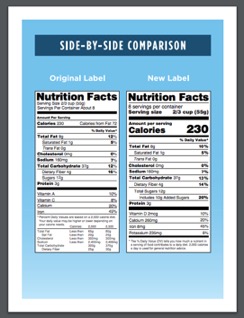Making Sense of Nutrition and Supplement Labeling Revisions
What has changed?
In 2016, the Food and Drug Administration (FDA) handed down updated requirements for the labeling of Nutrition Facts and Supplement Facts with a compliance date of January 1, 2020. It is the intention of the FDA to help consumers make better-informed choices about the food they eat and the supplements they take. The changes are based on updated scientific information (including the link between diet and health), more recent dietary recommendations from expert groups, and input from the public. The updated requirements also correspond to new information on consumer understanding and consumption patterns.
Summary of major changes:
List of required nutrients that must be declared on the label
| Now Required | No Longer Required |
| Vitamin D and Potassium. Based on nationwide surveys, Americans don’t always get enough of these two nutrients from their diet, and deficiencies are associated with increased risk of chronic disease. | Vitamins A and C. Because deficiencies of these nutrients are rare in the general population today, they are no longer required. |
| Added Sugars. This includes sugars that are either added during the processing of foods, or packaged as such (e.g., a bag of table sugar). It also includes sugars from syrups, honey, concentrated fruit, or vegetable juices. | Calories From Fat. It is now known that the type of fat (e.g., olive oil versus margarine) is more important than the amount of fat consumed. |
Serving size requirements
- Serving sizes must be based on the amount people are actually eating and drinking, rather than the amount they should be. How much food and drink people consume has changed in the US since the previous serving size requirements were established in 1993.
EXAMPLE: One serving size of yogurt was previously 8 ounces, this amount is changing to 6 ounces, to reflect the amount Americans typically consume in one sitting.
Units of measure for some nutrients
- “IU” will no longer be used as the primary unit of measure for vitamins A, D, and E.
- Vitamin A will now be declared in mcg RAE (Retinol Activity Equivalents).
- Vitamin D will be declared in mcg (although IUs may still be declared in addition to mcg).
- Vitamin E will be declared in mg.
EXAMPLE: Vitamin D 75 mcg (3,000 IU)
- Folate and folic acid will be declared in mcg DFE (Dietary Folate Equivalents) instead of mcg.
EXAMPLE: Folate 1,335 mcg DFE (800 mcg folic acid)
Daily values
Daily values are reference amounts of nutrients to consume or not to exceed. They are being updated based on newer scientific evidence that was used in the development of the 2015-2020 Dietary Guidelines for Americans, and in turn, this will affect the percent Daily Value (% DV) that is seen on Nutrition Facts and Supplement Facts labels.
| Nutrients with increased daily values | Calcium, dietary fiber, magnesium, manganese, phosphorus, potassium, total fat, vitamin C, and vitamin K |
| Nutrients with decreased daily values | Biotin, chloride, chromium, copper, molybdenum, niacin, pantothenic acid, riboflavin, selenium, sodium, thiamin, total carbs, vitamin B6, vitamin B12, and zinc |
Refreshed look and design of Nutrition Facts labels
Products categorized as Dietary Supplements are labeled with Supplement Facts. The look and design of Supplement Facts boxes will remain the same. However, products categorized as “food” by the FDA are labeled with Nutrition Facts. These will be updated:
- “Calories,” “servings per container,” and “Serving size” declarations are now in larger and/or bolder type.
- The footnote is changing to more clearly define “percent Daily Value.”

Source: FDA.gov. Changes to the Nutrition Facts Label.
What does this mean for Bariatric Advantage® products?
Simply put, change happens. Bariatric Advantage is at the forefront of the FDA labeling changes to ensure a higher level of transparency so that you know how much of each nutrient is in our products. Additionally, it’s important to remember that the recommended daily values are based on the general population, not on metabolic and bariatric surgery patients who have different nutritional needs. See our blog post (Essential Guide to Sleeve and Bypass Nutrition Needs) on how to select a vitamin supplement for more specific information pertaining to post-surgical nutrition needs.






